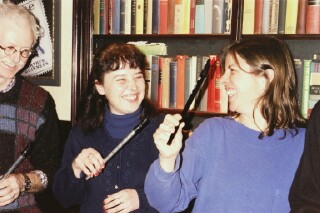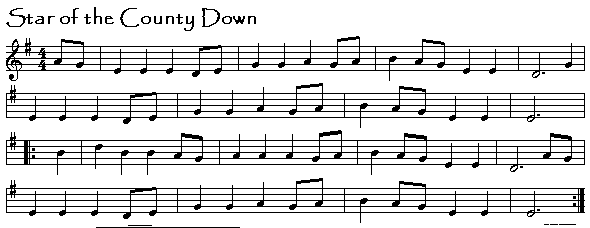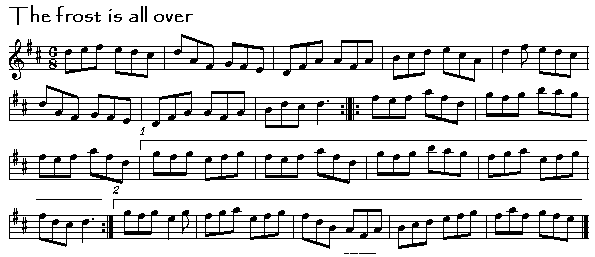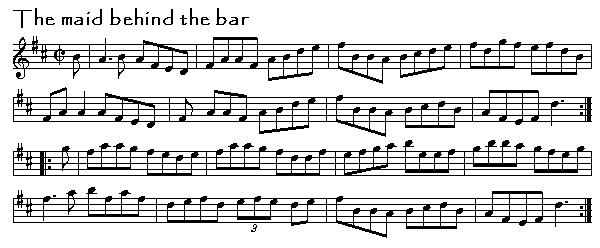A few words about tonguing
To tongue or not to tongue
And when: that is the question. And it's a tricky one. As with many aspects of Irish traditional music, there can be no hard and fast rules.
 At one end of the tonguing spectrum, I have a recording of the great uillean piper Seamus Ennis
playing a jig on the whistle in which he tongues about twice. At the other
end, I have a recording of Donegal whistle wizard Packie Manus Byrne playing
a jig in which every note is tongued, bar about two. Both are fine examples
of traditional playing, with great lift and rhythm.
At one end of the tonguing spectrum, I have a recording of the great uillean piper Seamus Ennis
playing a jig on the whistle in which he tongues about twice. At the other
end, I have a recording of Donegal whistle wizard Packie Manus Byrne playing
a jig in which every note is tongued, bar about two. Both are fine examples
of traditional playing, with great lift and rhythm.
In between these two extremes almost every degree of variation is possible. You'll have to work out your own tonguing style, but I can give you a few tips, plus an exercise to help you find what you like. I cannot stress enough the importance of listening to a wide variety good players. See my rant on this subject under Meditations.
Basics of tonguing
You tongue by saying "t" ("tuh") to start a note with a good clean attack. It's probably best to touch the tongue on the hard palate just behind your top teeth, rather than directly on the mouthpiece of the whistle, although in truth I think my tongue does come into light contact with the mouthpiece a lot of the time (depending on the whistle I'm playing). Using the hard palate will help you keep saliva out of the windway, and will also help you tongue much more quickly and cleanly. (The value of this second point will become apparent when you tackle advanced techniques such as triple tonguing).
Having said that there can be no rules, I'm going to give you three - just to start you off. (You can try breaking them later on.) Actually these three rules all boil down to the same basic thing.
- Always tongue after you have taken a breath. This includes the very first note of the tune.
- In the early stages, I'd recommend that you don't articulate a note in the above situation by simply starting to blow without tonguing. The chances are you'll sound like five-year-old who has just picked up a recorder for the first time - not pretty! Later however, it may be useful - see the sidebar below on "just blowing".
- If you have developed the habit of articulating notes by stopping your breath in your throat (making a glottal stop) or by giving a little cough, I'd recommend you abandon it in favour of tonguing. It constricts your throat, and is likely to lead to your making little grunting noises as you play. See the sidebar below.
Exercise: strip out all tonguing
Having just given you tips for how to tongue, the rest of this page is all about NOT tonguing! Here's an exercise I recommend to students. It is valuable in helping you decide when you want to tongue, and to show you the possibilites of not tonguing. It is particularly valuable for flute and recorder players who have come from to Irish music from some other style of music.
Beginners often tongue too much, or in places that set up the wrong kind of feel for the tune. So it's interesting to get rid of all tonguing first, and then put it back in places that make sense.
In this exercise, you get to pretend you're a highland bagpipe. Try to play an entire tune without tonguing (other than the first note of the tune and the first note after every breath). Set up an airstream and just keep it flowing until you need to breathe.
To deal with repeated notes, you use grace notes. For this, you'll need to study the topic on cuts. You could also use taps. But don't cheat by stopping the breath in your throat instead of tonguing!
Some examples
Here are a couple of tunes to show you the kind of effect you will get by eschewing (ouch!) your tongue. First, a simple song tune in march time, associated with The star of the County Down and other songs.

|
Listen to a tongueless Star of County Down (101K) |
I have used mainly cuts and the occasional tap to provide all the articulation between repeated notes in this clip.
And for something slightly more complex, here's a jig. I've picked an easy one for you, The frost is all over -- easy for the purposes of this exercise, because it doesn't have many repeated notes.

|
The tongue is all over! No repeats (80K) |
I've played this without repeats to keep the file size down. Notice that as well as using cuts to separate notes of the same pitch (e.g., the two As in the middle of bar 3), I have also used them to add a bit of interest here and there, often to emphasise the first beat of the bar. You will also have spotted that I chose to breathe, not at the end of the first part, but after the first beat of the first bar of the second part -- illustrating a point I make in the topic about breathing.
Lastly, here's a reel, The maid behind the bar. You may not be up to this tune yet, but it gives you an idea of the possibilities of not tonguing.

|
The maid behind the bar has lost her tongue! No repeats (77K) |
There you go -- want to play in an authentic traditional style, much like an "open-style" uillean piper playing whistle? Just stop tonguing, and you're practically there! Some whistlers today do play in a style a lot like the above clips. I'm not one of them by the way -- I tongue quite a lot. But I myself find it good practice to do this no-tonguing exercise, and I should probably do it more often!
What's next?
I may get around to adding more to this page, but it's a complex subject, and for now I'll leave you on your own.
Tonguing is really a matter of personal choice. It's a trade-off between flow and attack. (Less tonguing, more flow; more tonguing, more rhythmic possibilities. See Croutons in the soup -- coming soon.)
Ultimately how much you tongue will depend on the feeling you want to express in your playing. In the early stages, listen carefully to good players and notice how their use of tonguing differs.
I talk about tonguing elsewhere in this site, in the topics on Jigs - trickier than you think and Triplets (coming soon).
Next page: Where do I breathe?
Previous page: Relax!
Site contents: Back to the home page
Updated: 14 April 2004

